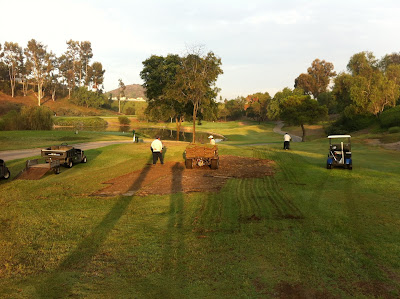Of course, we were all very excited when we found a new water source and especially thrilled when the water poured into our new reservoir. Now that this water is being used to irrigate the course, we can begin to see some of the results. As most cultural practices at a course build on a cumulative basis, the new water will follow suit and slowly change the environment for better, and in some ways, for worse. (don't worry, we can undo the bad stuff)
1. Financial savings
In short, the course has been spending 1/2 a million dollars per year on city water. The new pump station is currently feeding 2/3 of the course. Subtract the added electrical expense for pumping and you still have a very nice amount of savings. This is, by far, the well's greatest impact and the reason we went through so much trouble.
2. Additional irrigated locations
When you're spending so much on water, you need to cut back. Now that the bill has been greatly reduced, we are returning some of the irrigation in playable locations and our landscaping. All turf areas are being converted to bermudagrass, so the water savings is still huge compared to the green of ryegrass. The slopes that border most holes have been shut off and the acacias, silverberries, pyracanthas, and trees have suffered. Water is being returned to all these locations as quickly as possible.
3. Equal pressure all the time
This is not a benefit I had counted on, but it's a big one. The previous irrigation system was charged with five separate points of connection to the city supply. When many heads where running during the night, the water flow could not keep a steady pressure to all areas of the course. Booster pumps where added, but the pressure still varied greatly and reduced efficiency and uniformity. The new system, a very smart pump house, maintains pressure equally and constantly. From the moment each sprinkler is turned on to when it drops back below the surface, the pressure is at 80 psi and the coverage is greatly improved.
4. Increased salinity
Most water in Southern California, including potable water, is pretty hard and high in salt content. The groundwater has a TDS (total dissolved solids) that is more than twice the amount we had been using, but the quality is still in the acceptable range for turfgrass. Basically, the bermuda won't care, but the Poa annua and bentgrass greens could struggle. We will monitor the sodium levels in the greens very closely and flush out the salts when necessary. Frequent applications of calcium and organic acid will help greatly.
There have been some rumors around the club that the water needed blending to use, but that is not true. We are using the well water just as we expected and have many ways to combat the increased salinity. I will detail those practices in a future post. We will not know the true impact of this water source until next summer when the greens require more water, and therefore, more of the nasty stuff that comes with it. So far, we are seeing what we expected and perceive it to be a very manageable situation.
5. Deep watering
Bermudagrass can push roots very deep into the soil, sometimes many feet. If we can't get the water down there, the roots are not going to go searching below the surface. Deep watering was cost prohibitive for our fairways and difficult to achieve due to layering in the upper portion from topdressing and infrequent aerification. Now that we have a new water source, and more importantly a new aerifier, we will be able to push water deep to encourage deep roots and strong grass.
So that is my take on the top 5 impacts of the new well to your course. I'm happy to report that all systems are running perfectly, the increased pressure has not had any negative effects, and the well is pumping the same amount of water as it did when first tested.
 The October bunker renovation on holes 5, 6, and 7 finished with some left over sand. Part of conducting this work within a seven day window is making sure we have enough product, so we erred on the side of caution. We stockpiled some bunker sand in the shop for future use and needed to use up what remained. Most bunkers call for a major overhaul complete with a lot of earth moving. The chipping bunker just needs some sand to practice shots so it was an obvious choice to be renovated in-house.
The October bunker renovation on holes 5, 6, and 7 finished with some left over sand. Part of conducting this work within a seven day window is making sure we have enough product, so we erred on the side of caution. We stockpiled some bunker sand in the shop for future use and needed to use up what remained. Most bunkers call for a major overhaul complete with a lot of earth moving. The chipping bunker just needs some sand to practice shots so it was an obvious choice to be renovated in-house.
















































